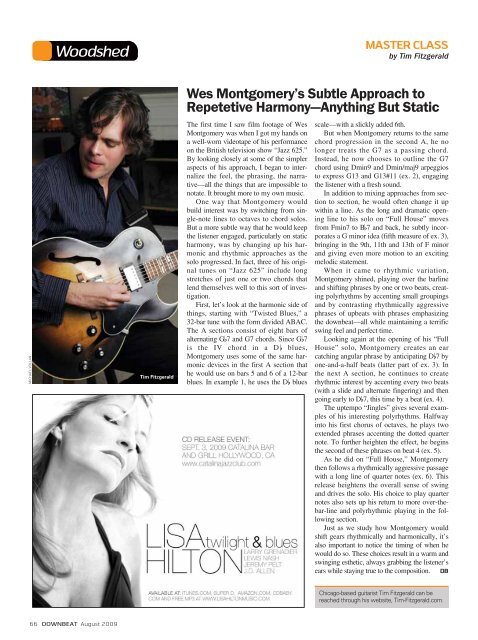Download - Downbeat
Download - Downbeat
Download - Downbeat
- No tags were found...
You also want an ePaper? Increase the reach of your titles
YUMPU automatically turns print PDFs into web optimized ePapers that Google loves.
WoodshedMASTER CLASSby Tim FitzgeraldMICHAEL VOLLANTim FitzgeraldWes Montgomery’s Subtle Approach toRepetetive Harmony—Anything But StaticThe first time I saw film footage of WesMontgomery was when I got my hands ona well-worn videotape of his performanceon the British television show “Jazz 625.”By looking closely at some of the simpleraspects of his approach, I began to internalizethe feel, the phrasing, the narrative—allthe things that are impossible tonotate. It brought more to my own music.One way that Montgomery wouldbuild interest was by switching from single-notelines to octaves to chord solos.But a more subtle way that he would keepthe listener engaged, particularly on staticharmony, was by changing up his harmonicand rhythmic approaches as thesolo progressed. In fact, three of his originaltunes on “Jazz 625” include longstretches of just one or two chords thatlend themselves well to this sort of investigation.First, let’s look at the harmonic side ofthings, starting with “Twisted Blues,” a32-bar tune with the form divided ABAC.The A sections consist of eight bars ofalternating G♭7 and G7 chords. Since G♭7is the IV chord in a D ♭ blues,Montgomery uses some of the same harmonicdevices in the first A section thathe would use on bars 5 and 6 of a 12-barblues. In example 1, he uses the D♭ bluesscale—with a slickly added 6th.But when Montgomery returns to the samechord progression in the second A, he nolonger treats the G7 as a passing chord.Instead, he now chooses to outline the G7chord using Dmin9 and Dmin/maj9 arpeggiosto express G13 and G13#11 (ex. 2), engagingthe listener with a fresh sound.In addition to mixing approaches from sectionto section, he would often change it upwithin a line. As the long and dramatic openingline to his solo on “Full House” movesfrom Fmin7 to B♭7 and back, he subtly incorporatesa G minor idea (fifth measure of ex. 3),bringing in the 9th, 11th and 13th of F minorand giving even more motion to an excitingmelodic statement.When it came to rhythmic variation,Montgomery shined, playing over the barlineand shifting phrases by one or two beats, creatingpolyrhythms by accenting small groupingsand by contrasting rhythmically aggressivephrases of upbeats with phrases emphasizingthe downbeat—all while maintaining a terrificswing feel and perfect time.Looking again at the opening of his “FullHouse” solo, Montgomery creates an earcatching angular phrase by anticipating D♭7 byone-and-a-half beats (latter part of ex. 3). Inthe next A section, he continues to createrhythmic interest by accenting every two beats(with a slide and alternate fingering) and thengoing early to D♭7, this time by a beat (ex. 4).The uptempo “Jingles” gives several examplesof his interesting polyrhythms. Halfwayinto his first chorus of octaves, he plays twoextended phrases accenting the dotted quarternote. To further heighten the effect, he beginsthe second of these phrases on beat 4 (ex. 5).As he did on “Full House,” Montgomerythen follows a rhythmically aggressive passagewith a long line of quarter notes (ex. 6). Thisrelease heightens the overall sense of swingand drives the solo. His choice to play quarternotes also sets up his return to more over-thebar-lineand polyrhythmic playing in the followingsection.Just as we study how Montgomery wouldshift gears rhythmically and harmonically, it’salso important to notice the timing of when hewould do so. These choices result in a warm andswinging esthetic, always grabbing the listener’sears while staying true to the composition. DBChicago-based guitarist Tim Fitzgerald can bereached through his website, Tim-Fitzgerald.com.66 DOWNBEAT August 2009
















